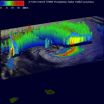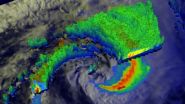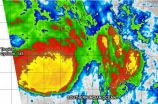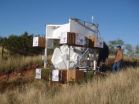(Press-News.org) Imagine receiving as much as 7 inches of rain in one hour. That's about what NASA's TRMM satellite spotted falling in one area within Tropical Cyclone Edilson as it moved over the Southern Indian Ocean.
The Tropical Rainfall Measuring Mission or TRMM satellite is managed by both NASA and the Japan Aerospace Exploration Agency called JAXA. TRMM can read the rate in which rain is falling on Earth while in its orbit high above.
The TRMM satellite had an excellent early morning look at Edilson on February 7, 2014 at 0237 UTC/06:28 local time when it passed directly above the tropical cyclone. A rainfall analysis from TRMM's Microwave Imager (TMI) and Precipitation Radar (PR) instruments was overlaid on an enhanced visible/infrared image from TRMM's Visible and InfraRed Scanner (VIRS) at NASA's Goddard Space Flight Center in Greenbelt, Md. to create a total picture of the storm.
VIDEO:
During a Feb. 7 flyby, TRMM saw Edilson's highest thunderstorm tops, reaching heights over 14.75km/~9.1 miles located east of Edilson's center.
Click here for more information.
Rainfall data showed Edilson south of La Reunion and Mauritius Islands dropping its heaviest rain at a rate of over 175mm/~6.9 inches per hour in an intense feeder band on the eastern side of the tropical cyclone.
TRMM's PR data sliced through Edilson providing data for a 3-D look inside the tropical cyclone. Those data revealed that the highest thunderstorm tops, reaching heights over 14.75km/~9.1 miles were also located in the feeder band east of Edilson's center of circulation.
At 1500 UTC/10 a.m. EST on February 7, the Joint Typhoon Warning Center or JTWC noted that Edilson was located near 29.7 south and 53.9 east, about 508 nautical miles/584.6 miles/940.8 km south of Saint Denis. Edilson's maximum sustained winds were near 50 knots/57 mph/92.6 kph. The tropical storm is moving to the south-southwest at 16 knots/18.4 mph/29.6 kph.
Since the TRMM satellite passed over Edilson, the strongest thunderstorms have weakened as convection has decayed. That's because Edilson is now located within an upper-level shortwave trough (elongated area of low pressure) and is being battered with strong northerly vertical wind shear between 20 and 30 knots/23.0 to 34.5 mph/37.0 to 55.5 kph).
Edilson is expected to continue on a southerly track over the next several days as it becomes extra-tropical over open waters of the Southern Indian Ocean.
INFORMATION:
Text credit: Hal Pierce/Rob Gutro
SSAI/NASA's Goddard Space Flight Center
NASA spots very heavy rainfall rates in Tropical Cyclone Edilson
2014-02-08
ELSE PRESS RELEASES FROM THIS DATE:
Diaphragm pacing in spinal cord injury successful in weaning patients from ventilators
2014-02-08
CLEVELAND – A new study published in the Journal of Trauma and Acute Care Surgery finds that diaphragm pacing (DP) stimulation in spinal cord-injured patients is successful not only in weaning patients from mechanical ventilators but also in bridging patients to independent respiration, where they could breathe on their own without the aid of a ventilator or stimulation.
The stimulation is provided by the Diaphragm Pacing System (DPS), a technology providing electrical stimulation to nerves running through the diaphragm, the major muscle involved in breathing. When stimulated, ...
NASA spots fourteenth tropical cyclone of Southern Indian Ocean season
2014-02-08
The fourteenth tropical cyclone of the Southern Indian Ocean season was born as NASA's Terra satellite passed overhead.
On February 7 at 0900 UTC/4 a.m. EST, Tropical Cyclone 14S had maximum sustained winds near 35 knots/40 mph/62 kph. It was located about 814 nautical miles/936.7 miles/1,508 km east-northeast of Port Louis, Mauritius near 14.8 south and 70.4 east. At that time, 14S was moving to the south near 8 knots/9.2 mph/14.8 kph.
The Joint Typhoon Warning Center noted that multispectral satellite imagery showed that the low-level center is exposed to outside ...
Thinking skills take biggest hit from anxiety in midlife women with HIV
2014-02-08
CLEVELAND, Ohio (Friday, February 7, 2014)—Hot flashes, depression, and most of all, anxiety, affect the thinking skills of midlife women with HIV, so screening for and treating their anxiety may be especially important in helping them function, according to a study just published online in Menopause, the journal of The North American Menopause Society (NAMS). The reproductive stage, whether it was premenopause, perimenopause or postmenopause, did not seem to be related to these women's thinking skills.
The conclusions come from a new analysis of data on 708 HIV-infected ...
WASP gives NASA's planetary scientists new observation platform
2014-02-08
Scientists who study Earth, the sun and stars have long used high-altitude scientific balloons to carry their telescopes far into the stratosphere for a better view of their targets. Not so much for planetary scientists. That's because they needed a highly stable, off-the-shelf-type system that could accurately point their instruments and then track planetary targets as they moved in the solar system.
That device now exists.
NASA's Wallops Flight Facility in Wallops Island, Va., has designed a new pointing system — the Wallops Arc Second Pointer (WASP) — that can point ...
Study provides surprising new clue to the roots of hunger
2014-02-07
BOSTON – While the function of eating is to nourish the body, this is not what actually compels us to seek out food. Instead, it is hunger, with its stomach-growling sensations and gnawing pangs that propels us to the refrigerator – or the deli or the vending machine. Although hunger is essential for survival, abnormal hunger can lead to obesity and eating disorders, widespread problems now reaching near-epidemic proportions around the world.
Over the past 20 years, Beth Israel Deaconess Medical Center (BIDMC) neuroendocrinologist Bradford Lowell, MD, PhD, has been untangling ...
New method developed for ranking disease-causal mutations within whole genome sequences
2014-02-07
Seattle, Wash. and Huntsville, Ala.—Researchers from the University of Washington and the HudsonAlpha Institute for Biotechnology have developed a new method for organizing and prioritizing genetic data. The Combined Annotation–Dependent Depletion, or CADD, method will assist scientists in their search for disease-causing mutation events in human genomes.
The new method is the subject of a paper titled "A general framework for estimating the relative pathogenicity of human genetic variants," published in Nature Genetics.
Current methods of organizing human genetic variation ...
Study identifies protein to repair damaged brain tissue in MS
2014-02-07
Vittorio Gallo, PhD, Director of the Center for Neuroscience Research at Children's National Health System, and other researchers have found a "potentially novel therapeutic target" to reduce the rate of deterioration and to promote growth of brain cells damaged by multiple sclerosis (MS). Current therapies can be effective in patients with relapsing MS, but have little impact in promoting tissue growth.
The brain produces new cells to repair the damage from MS years after symptoms appear. However, in most cases the cells are unable to complete the repair, as unknown ...
Analysis of calls to IBD clinic predicts emergency visits and hospitalizations, Pitt finds
2014-02-07
PITTSBURGH, Feb. 7, 2014 – A comprehensive analysis of patient telephone records at an inflammatory bowel disease (IBD) clinic revealed that 15 percent of patients account for half of all calls to the clinic. Forty-two percent of frequent-caller patients also were seen in the emergency department or hospitalized within the following year.
The results, which can help doctors identify patients with the most severe disease and those at risk of potentially avoidable high-cost medical interventions, were reported in a study published online this week in the journal Clinical ...
Ice age's arctic tundra lush with wildflowers for woolly mammoths, study finds
2014-02-07
MANHATTAN, Kan. -- A recent study in the journal Nature finds that nearly 50,000 years ago during the ice age, the landscape was not as drab as once thought -- it was filled with colorful wildflowers. These wildflowers helped sustain woolly mammoths and other giant grazing animals.
The study, "Fifty thousand years of Arctic vegetation and megafauna diet," included Joseph Craine, assistant professor in the Division of Biology at Kansas State University. It was led by the Centre for GeoGenetics at the University of Copenhagen and was a collaboration of more than 25 academic ...
Bottom-up insight into crowd dynamics
2014-02-07
Stampedes unfortunately occur on too regular a basis. Previously, physicists developed numerous models of crowd evacuation dynamics. Their analyses focused on disasters such as the yearly Muslim Hajj or of the Love Parade disaster in Germany in 2010. Unfortunately, the casualties at these events may have been linked to the limitations of the crowd dynamics models used at the time. Now, a new study outlines a procedure for quantitatively comparing different crowd models, which also helps to compare these models with real-world data. In a paper published in EPJ B, Vaisagh ...



